ESP PORSCHE 911 2014 6.G Information Manual
[x] Cancel search | Manufacturer: PORSCHE, Model Year: 2014, Model line: 911, Model: PORSCHE 911 2014 6.GPages: 75, PDF Size: 11.41 MB
Page 3 of 75
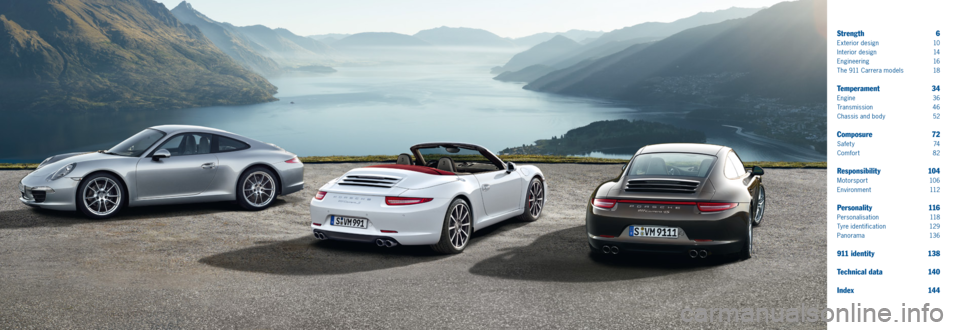
Strength 6
Exterior design 10
Interior design 14
Engineering 16
The 911 Carrera models 18
Temperament 34
Engine 36
Tr a n s m i s s i o n 4 6
Chassis and body 52
Composure 72
S a f e t y 74
Comfort 82
Responsibility 104
Motorsport 106
Environment 112
Personality 116
Personalisation 118
Tyre identification 129
Panorama 136
911 identity 138
Technical data 140
Index 144
Page 5 of 75

9
8
Many legends look to the past.
This one looks to the future.
T h e 9 11 .
It ’s time to look forward. Because,
traditionally, the 911 has always had
an eye to the future.
Our own engineering tradition is evident
from the ‘Dr. Ing.’ in our company name.
Also from our racing victories, now
totalling more than 30,000. Not only
more feats of heroism, but responsibilit y
for the future of the sports car and for
the environment. Then there is the 911’s
reputation as an iconic sports car.
However, this reputation means nothing
unless we continue to breathe new life
into old ideas. For us, heritage and future
are inseparably linked. Of course, we
could simply have made a capable sports car, but this wouldn’t have been a
Porsche, and certainly not a 911.
Our identit y is the 911. This is also, and
especially, true in the 21st century.
Instantly recognisable and originally
engineered for the racetrack, it continues
to stir the emotions today, just as it did
i n 19 6 3.
Yet, is that enough to move forward?
Above all, is it enough for you? Don’t we
need to break the stranglehold of
tradition once in a while before it one day
stifles innovation altogether? We believe
that the answer is ‘yes’. This is our
approach to the preservation of tradition. It is precisely how we respond to the
passion for the sports car and do justice
to the 911 legend – and always with
tomorrow in mind.
We have achieved this with a future-
oriented design, with engines that
consume comparatively little but deliver
a considerable amount of power, with
efficiency-enhancing technologies such
as auto start /stop, thermal management
and electrical system recuperation,
with intelligent lightweight construction,
with an innovative hood concept on the
Cabriolet models, with Porsche Traction
Management (PTM) active all-wheel
drive, and with an interior that combines sophisticated ergonomics and sporty
comfor t.
All of that is what defines us. In short, it
is the way in which we combine tradition
and innovation, performance and every
-
day practicality, form and function. For
us, these are not contradictions, but our
moti vation. We are referring to Intelligent
Performance.
Our identit y can be accurately described
by many words. And three digits.
The 911. Porsche Identit y.
For fuel consumption, CO
2 emissions and efficiency class, please refer to pages 141/143.
S trength | The 911
Page 7 of 75
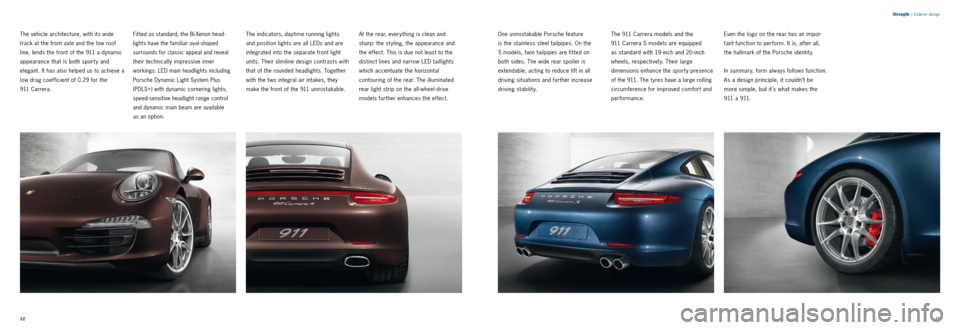
1213
S
trength
| Exterior design
The vehicle architecture, with its wide
track at the front axle and the low roof
line, lends the front of the 911 a dynamic
appearance that is both sport y and
elegant. It has also helped us to achieve a
low drag coefficient of 0.29 for the
9 11 C a r r e r a .
Fit ted as standard, the Bi-Xenon head -
lights have the familiar oval-shaped
surrounds for classic appeal and reveal
their technically impressive inner
workings. LED main headlights including
Porsche Dynamic Light System Plus
(PDLS +
) with dynamic cornering lights,
speed-sensitive headlight range control
and dynamic main beam are available
as an option.
The indicators, daytime running lights
and position lights are all LEDs and are
integrated into the separate front light
units. Their slimline design contrasts with
that of the rounded headlights. Together
with the two integral air intakes, they
make the front of the 911 unmistakable. At the rear, every thing is clean and
sharp: the styling, the appearance and
the effect. This is due not least to the
distinct lines and narrow LED taillights
which accentuate the horizontal
contouring of the rear. The illuminated
rear light strip on the all-wheel- drive
models further enhances the effect. One unmistakable Porsche feature
is the stainless steel tailpipes. On the
S models, t win tailpipes are fit ted on
both sides. The wide rear spoiler is
extendable, acting to reduce lift in all
driving situations and further increase
driving stability.
The 911 Carrera models and the
911 Carrera S models are equipped
as standard with 19-inch and 20 -inch
wheels, respectively. Their large
dimensions enhance the sporty presence
of the 911. The t yres have a large rolling
circumference for improved comfort and
performance. Even the logo on the rear has an impor
-
tant function to perform. It is, after all,
the hallmark of the Porsche identity.In summary, form always follows function.
As a design principle, it couldn’t be
more simple, but it ’s what makes the
9 11 a 9 11 .
Page 8 of 75
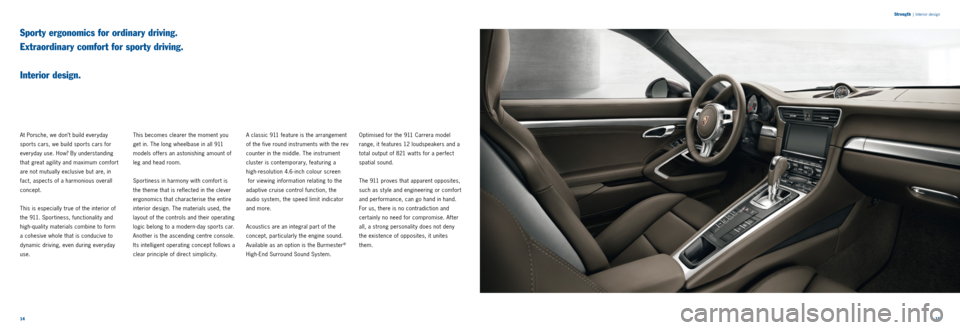
1415
S
trength
| Interior design
Sporty ergonomics for ordinary driving.
Extraordinary comfort for sporty driving.
Interior design.
At Porsche, we don’t build everyday
sports cars, we build sports cars for
everyday use. How? By understanding
that great agilit y and maximum comfort
are not mutually exclusive but are, in
fact, aspects of a harmonious overall
concept.
This is especially true of the interior of
the 911. Sportiness, functionality and
high-quality materials combine to form
a cohesive whole that is conducive to
dynamic driving, even during everyday
use. This becomes clearer the moment you
get in. The long wheelbase in all 911
models offers an astonishing amount of
leg and head room.
Sportiness in harmony with comfort is
the theme that is reflected in the clever
ergonomics that characterise the entire
interior design. The materials used, the
layout of the controls and their operating
logic belong to a modern- day sports car.
Another is the ascending centre console.
Its intelligent operating concept follows a
clear principle of direct simplicity.A classic 911 feature is the arrangement
of the five round instruments with the rev
counter in the middle. The instrument
cluster is contemporary, featuring a
high-resolution 4.6-inch colour screen
for viewing information relating to the
adaptive cruise control function, the
audio system, the speed limit indicator
and more.
Acoustics are an integral part of the
concept, particularly the engine sound.
Available as an option is the Burmester
®
High-End Surround Sound System. Optimised for the 911 Carrera model
range, it features 12 loudspeakers and a
total output of 821 wat ts for a perfect
spatial sound.
The 911 proves that apparent opposites,
such as st yle and engineering or comfort
and performance, can go hand in hand.
For us, there is no contradiction and
certainly no need for compromise. After
all, a strong personalit y does not deny
the existence of opposites, it unites
them.
Page 10 of 75
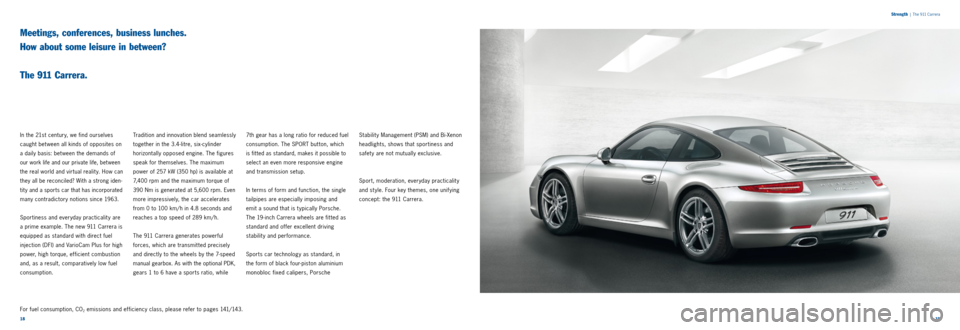
1819
S
trength
| The 911 Carrera
Meetings, conferences, business lunches.
How about some leisure in between?
The 911 Carrera.
In the 21st century, we find ourselves
caught bet ween all kinds of opposites on
a daily basis: bet ween the demands of
our work life and our private life, between
the real world and virtual realit y. How can
they all be reconciled? With a strong iden -
tit y and a sports car that has incorporated
many contradictory notions since 1963.
Sportiness and everyday practicality are
a prime example. The new 911 Carrera is
equipped as standard with direct fuel
injection
(DFI) and VarioCam Plus for high
power, high torque, efficient combustion
and, as a result, comparatively low fuel
consumption. Tradition and innovation blend seamlessly
together in the 3.4-litre, six-cylinder
horizontally opposed engine. The figures
speak for themselves. The maximum
power of 257 kW (350 hp) is available at
7,400 rpm and the maximum torque of
390 Nm is generated at 5,600 rpm. Even
more impressively, the car accelerates
from 0 to 100 km/ h in 4.8 seconds and
reaches a top speed of 289 km/ h.
The 911 Carrera generates powerful
forces, which are transmit ted precisely
and directly to the wheels by the 7-speed
manual gearbox. As with the optional PDK,
gears 1 to 6 have a sports ratio, while 7th gear has a long ratio for reduced fuel
consumption. The SPORT but ton, which
is fit ted as standard, makes it possible to
select an even more responsive engine
and transmission setup.
In terms of form and function, the single
tailpipes are especially imposing and
emit a sound that is t ypically Porsche.
The 19-inch Carrera wheels are fit ted as
standard and offer excellent driving
stability and performance.
Sports car technology as standard, in
the form of black four-piston aluminium
monobloc fixed calipers, Porsche
Stabilit y Management (PSM) and Bi-Xenon
headlights, shows that sportiness and
safet y are not mutually exclusive.
Sport, moderation, everyday practicality
and st yle. Four key themes, one unifying
concept: the 911 Carrera.
For fuel consumption, CO
2 emissions and efficiency class, please refer to pages 141/143.
Page 13 of 75
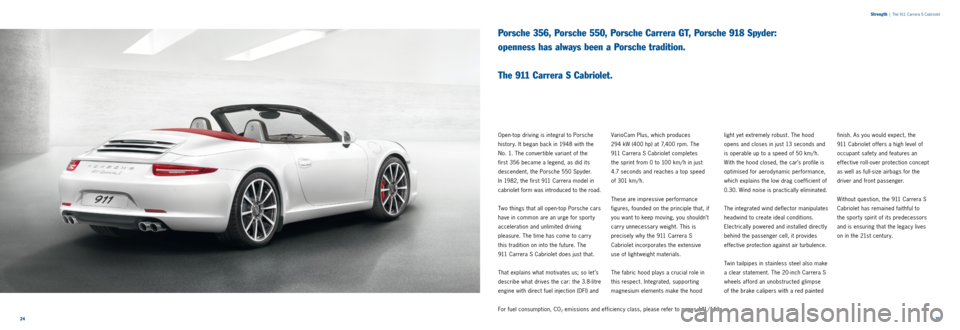
2425
S
trength
| The 911 Carrera S Cabriolet
Porsche 356, Porsche 550, Porsche Carrera GT, Porsche 918 Spyder:
openness has always been a Porsche tradition.
The 911 Carrera S Cabriolet.
Open-top driving is integral to Porsche
history. It began back in 1948 with the
No. 1. The convertible variant of the
first 356 became a legend, as did its
descendent, the Porsche 550 Spyder.
In 1982, the first 911 Carrera model in
cabriolet form was introduced to the road.
Two things that all open-top Porsche cars
have in common are an urge for sport y
acceleration and unlimited driving
pleasure. The time has come to carry
this tradition on into the future. The
911 Carrera S Cabriolet does just that.
That explains what motivates us; so let ’s
describe what drives the car: the 3.8-litre
engine with direct fuel injection (DFI) and
VarioCam Plus, which produces
294 kW (400 hp) at 7,400 rpm. The
911 Carrera S Cabriolet completes
the sprint from 0 to 100 km/ h in just
4.7 seconds and reaches a top speed
of 301 km/ h.
These are impressive performance
figures, founded on the principle that, if
you want to keep moving, you shouldn’t
carry unnecessary weight. This is
precisely why the 911 Carrera S
Cabriolet incorporates the extensive
use of lightweight materials.
The fabric hood plays a crucial role in
this respect. Integrated, supporting
magnesium elements make the hood light yet extremely robust. The hood
opens and closes in just 13 seconds and
is operable up to a speed of 50 km/ h.
With the hood closed, the car’s profile is
optimised for aerodynamic performance,
which explains the low drag coefficient of
0.30. Wind noise is practically eliminated.
The integrated wind deflector manipulates
headwind to create ideal conditions.
Electrically powered and installed directly
behind the passenger cell, it provides effective protection against air turbulence.
Twin tailpipes in stainless steel also make
a clear statement. The 20 -inch Carrera S
wheels afford an unobstructed glimpse
of the brake calipers with a red painted
finish. As you would expect, the
911 Cabriolet offers a high level of
occupant safety and features an
effective roll-over protection concept
as well as full-size airbags for the
driver and front passenger.
Without question, the 911 Carrera S
Cabriolet has remained faithful to
the sporty spirit of its predecessors
and is ensuring that the legacy lives
on in the 21st century.
For fuel consumption, CO
2 emissions and efficiency class, please refer to pages 141/143.
Page 14 of 75
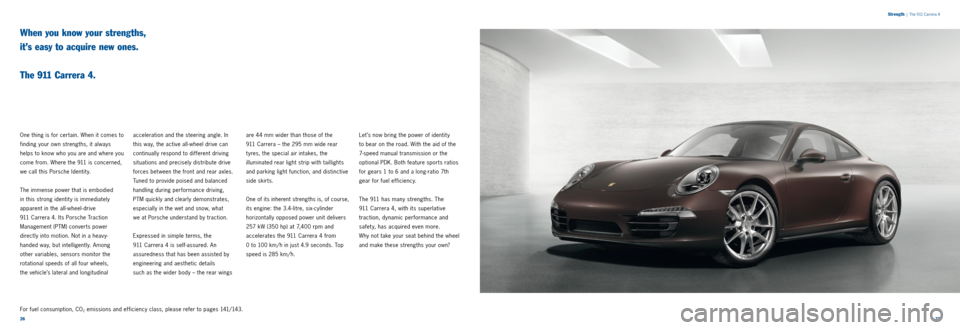
2627
When you know your strengths,
it’s easy to acquire new ones.
The 911 Carrera 4.
One thing is for certain. When it comes to
finding your own strengths, it always
helps to know who you are and where you
come from. Where the 911 is concerned,
we call this Porsche Identit y.
The immense power that is embodied
in this strong identit y is immediately
apparent in the all-wheel-drive
911 Carrera 4. Its Porsche Traction
Management (PTM) converts power
directly into motion. Not in a heav y-
handed way, but intelligently. Among
other variables, sensors monitor the
rotational speeds of all four wheels,
the vehicle’s lateral and longitudinal acceleration and the steering angle. In
this way, the active all-wheel drive can
continually respond to different driving
situations and precisely distribute drive
forces bet ween the front and rear axles.
Tuned to provide poised and balanced
handling during performance driving,
PTM quickly and clearly demonstrates,
especially in the wet and snow, what
we at Porsche understand by traction.
Expressed in simple terms, the
911 Carrera 4 is self-assured. An
assuredness that has been assisted by
engineering and aesthetic details
such as the wider body – the rear wings are 44 mm wider than those of the
911 Carrera – the 295 mm wide rear
tyres, the special air intakes, the
illuminated rear light strip with taillights
and parking light function, and distinctive
side skirts.
One of its inherent strengths is, of course,
its engine: the 3.4-litre, six-cylinder
horizontally opposed power unit delivers
257 kW (350 hp) at 7,400 rpm and
accelerates the 911 Carrera 4 from
0 to 100 km/ h in just 4.9 seconds. Top
speed is 285 km/ h.
Let ’s now bring the power of identit y
to bear on the road. With the aid of the
7-speed manual transmission or the
optional PDK.
Both feature sports ratios
for gears 1 to 6 and a long-ratio 7th
gear for fuel efficiency.
The 911 has many strengths. The
911 Carrera 4, with its superlative
traction, dynamic performance and
safet y, has acquired even more.
Why not take your seat behind the wheel
and make these strengths your own?
For fuel consumption, CO
2 emissions and efficiency class, please refer to pages 141/143.
S trength | The 911 Carrera 4
Page 15 of 75
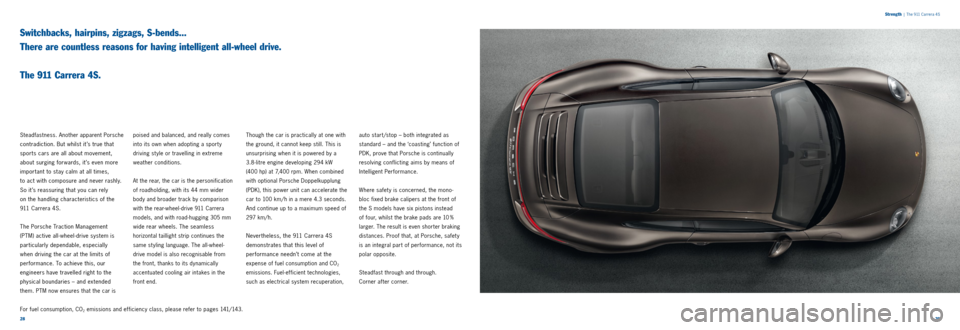
2829
Switchbacks, hairpins, zigzags, S-bends...
There are countless reasons for having intelligent all-wheel drive.
The 911 Carrera 4S.
Steadfastness. Another apparent Porsche
contradiction. But whilst it ’s true that
sports cars are all about movement,
about surging forwards, it ’s even more
important to stay calm at all times,
to act with composure and never rashly.
So it ’s reassuring that you can rely
on the handling characteristics of the
911 Carrera 4S.
The Porsche Traction Management
(PTM) active all-wheel- drive system is
particularly dependable, especially
when driving the car at the limits of
performance. To achieve this, our
engineers have travelled right to the
physical boundaries – and extended
them. PTM now ensures that the car is poised and balanced, and really comes
into its own when adopting a sport y
driving st yle or travelling in extreme
weather conditions.
At the rear, the car is the personification
of roadholding, with its 44 mm wider
body and broader track by comparison
with the rear-wheel- drive 911 Carrera
models, and with road-hugging 305 mm
wide rear wheels. The seamless
horizontal taillight strip continues the
same st yling language. The all-wheel-
drive model is also recognisable from
the front, thanks to its dynamically
accentuated cooling air intakes in the
front end.
Though the car is practically at one with
the ground, it cannot keep still. This is
unsurprising when it is powered by a
3.8-litre engine developing 294 kW
(400 hp) at 7,400 rpm. When combined
with optional Porsche Doppelkupplung
(PDK), this power unit can accelerate the
car to 100 km/ h in a mere 4.3 seconds.
And continue up to a maximum speed of
297 km/ h.
Nevertheless, the 911 Carrera 4S
demonstrates that this level of
performance needn’t come at the
expense of fuel consumption and CO2
emissions. Fuel-efficient technologies,
such as electrical system recuperation,
For fuel consumption, CO
2 emissions and efficiency class, please refer to pages 141/143.
S trength | The 911 Carrera 4S
auto start/stop – both integrated as
standard – and the ‘coasting’ function of
PDK, prove that Porsche is continually
resolving conflicting aims by means of
Intelligent Performance.
Where safety is concerned, the mono -
bloc fixed brake calipers at the front of
the S models have six pistons instead
of four, whilst the brake pads are 10 %
larger. The result is even shorter braking
distances. Proof that, at Porsche, safet y
is an integral part of performance, not its
polar opposite.
Steadfast through and through.
Corner after corner.
Page 19 of 75

3637
T
emperament
| Engine
To give more and take less.
That’s Porsche engineering.
Engines.
You could ask whether the sports car is
still relevant. It would be a good question,
but you might as well ask the same of
dreams.
The answer to both questions lies in the
future or, to be more precise, in the
future of the sports car. In the 911,
the future is already here. The highly
efficient, state-of-the-art engines make
a considerable contribution to the
comparatively low fuel consumption,
but their sound is still unmistakably
Porsche.
The 911 engines are also unmistakably
sport y thanks to the SPORT but ton fit ted
as standard. At a single push, the engine
becomes tuned for a sharper response
and engine dynamics that are even more
direct.
The 3.4-litre engine of the 911 Carrera
models demonstrates, therefore,
that performance and efficiency need
not be mutually exclusive. Rather, the
comparatively low engine capacity
combined with a high maximum torque
are the intelligent basis by which high
power output can be achieved in
an environmentally acceptable and
sustainable way.
In their search for improved efficiency,
our engineers analysed an extensive series
of engine components. Answers were
found, including rapid heating of the
engine and gearbox to normal operating
temperature after an engine start by the
thermal management system, improved
air induction and extremely effective
direct fuel injection (DFI).
Weight is critical to efficiency. This is
why the engines have a light-alloy
construction, making them lightweight
and yet structurally rigid. The result is
comparatively low fuel consumption and
a long service life. The engine is the intelligent core of our
identit y. What else could the ‘Dr. Ing.’ in
our company name possibly stand for?
For fuel consumption, CO
2 emissions and efficiency class, please refer to pages 141/143.
Page 25 of 75

462135
7R
4849
Porsche Doppelkupplung (PDK).
Available as an option for all
911
Carrera models is 7-speed PDK,
featuring manual and automatic modes.
It facilitates extremely fast gear changes
with no interruption in the flow of power,
whilst at the same time improving
acceleration and fuel efficiency. The first six gears are particularly
sport y, with top speed being reached
in 6th gear. 7th gear has a long
ratio and reduces the revs – for lower
consumption.
PDK is essentially t wo gearboxes in one
and thus requires t wo clutches. This
double-clutch arrangement provides an
Porsche Doppelkupplung (PDK)
alternating, non-positive connection
bet ween the t wo half gearboxes and the
engine by means of t wo separate input
shafts.
The flow of power from the engine is
transmit ted through one half gearbox and
one clutch at a time, while the next gear
is preselected in the second half gearbox. During a gear change, therefore, one
clutch simply opens and the other closes
at the same time, enabling gear changes
to take place within milliseconds.
The effect is instant. Driving feels even
sportier and more dynamic, and agility
is increased. Depending on the gearshift
programme (SPORT button activated
T emperament | Transmission
or deactivated), the gear change is opti -
mised for comfort or for sport y driving.
With the optional Sport Chrono Package,
PDK is enhanced by the ‘Launch Control’
and ‘motorsport-derived gearshift
strategy’ functions (pages 65– 67).
Coasting.
The ‘coasting’ function available with
Porsche Doppelkupplung (PDK) enables
you to save even more fuel where the
situation allows. The engine is decoupled
from the transmission to prevent
deceleration caused by engine braking.
In this way, optimum use is made of the
vehicle’s momentum, allowing it to coast
for longer distances.
For example, you may want to slow down
from 100 to 80 km/ h in anticipation
of the change of speed limit ahead. As
soon as you release the accelerator
pedal, PDK deselects the current gear automatically and you begin to coast
in neutral until you have reached your
desired speed. The moment you engage
the accelerator or brake pedal, PDK
selects the appropriate gear smoothly
and seamlessly within a fraction of a
second.
In short, driving in coasting mode makes
a real impact on fuel consumption without
any need for compromise on comfort or
sporty performance.
Another way to reduce fuel consumption is
to utilise the coasting function on downhill
gradients that are gentle enough for you
to maintain a constant speed. Efficient on
long journeys, such as on the motorway,
PDK remains ready to respond as swiftly
and precisely as you would expect.
For fuel consumption, CO
2 emissions and efficiency class, please refer to pages 141/143.